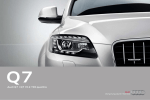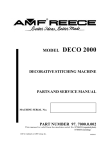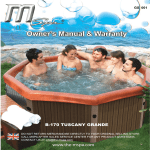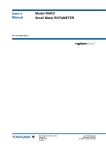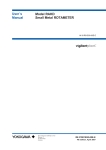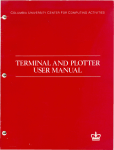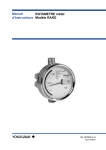Download York Fitness 56018 Operating instructions
Transcript
Form MHD56018 PARTS, OPERATION AND MAINTENANCE MANUAL for MANUAL CHAIN HOIST MODELS M E4-005 ME4-010 ME4-015 1/2 ton 1 ton 1-1/2 ton M E4-020 M E4-030 ME4-050 2 ton 3 ton 5 ton Including S•COR•E (Spark and Corrosion Resistant) Features Unless otherwise noted, tons in this manual are metric tons (2,200 Ibs.) (Dwg. MHTPA0066) (Dwg. MHTPA0067) (Dwg. MHTPAO068) 1/2, 1 and 1-1/2 ton 2 and 3 ton 5 ton READ THIS MANUAL BEFORE USING THESE PRODUCTS. This manual contains important safety, installation, operation and maintenance information. Make this manual available to all persons responsible for the operation, installation and maintenance of these products. Do not use this hoist for lifting, supporting, loads over people. or transporting people or lifting or supporting Always operate, ins ect and maintain this hoist in accordance with American National Standards Institute SafetyCode (ASME 830.16) and any other applicable safety codes and regulations. Refer all communications to the nearest Ingersoll-Rand Material Handling Products Office or Distributor. Form MHD56018 Edition 2 August 1993 71043160 © 1993 Ingersoll-Rand Company INGERSOLL-RAND, MATERIAL HANDLING This manual provides important information for all personnel involved with the safe installation, operation and proper maintenance of this product. Even if you feel you are familiar with this or similar equipment, you should read and understand this manual before operating the product. Danger, Warning, Caution and Notice Throughout this manual there are steps and procedures which, if not followed, may result in a injury. The following signal words are used to identify the level of potential hazard. Danger is used to indicate the presence of a hazard which will cause severe injury, death, or substantial property damage if the warning is ignored. Warning is used to indicate the presence of a hazard which can cause severe injury, death, or substantial property damage if the warning is ignored. Caution is used to indicate the presence of a hazard which will or can cause minor injury or property damage if the warning is ignored. Notice is used to notify people of installation, operation, or maintenance information which is important but not hazard-related. The National Safety Council, Accident Prevention Manual for Industrial Operations, Eighth Edition and other recognized safety sources make a common point: Employees who work near cranes or assist in hooking on or arranging a load should be instructed to keep out from under the load. From a safety standpoint, one factor is paramount: conduct all lifting operations in such a manner that if there were an equipment failure, no personnel would be injured. This means keep out from under a raised load and keep out of the line of force of any load. Ingersoll-Rand Material Handling hoists are manufactured in accordance with the latest ASME B30.16 standards. The Occupational Safety and Health Act of 1970, generally places the burden of compliance with the owner/employer, not the manufacturer. Many OSHA requirements are not concerned or connected with the manufactured product but are, rather, connected with the final installation. It is the owner’s responsibility and user’s responsibility to determine the suitability of a product for any particular use. It is recommended that all applicable industry, trade association, federal, state and local regulations be checked. Read all operating instructions and warnings before operation. Rigging: It is the responsibility of the operator to exercise caution, use common sense and be familiar with proper rigging techniques. See ASME B30.9 for rigging information, American National Standards Institute, 1430 Broadway, New York, NY 10018. Using other than genuine Ingersoll-Rand Handling parts may void the warranty. l Safety Summary Do not use this hoist for lifting, supporting, or transporting people or lifting or supporting loads over people. Hoists are designed to provide a 4 to 1 safety factor. The supporting structures and load-attaching devices used in conjunction with this hoist must provide adequate support to handle all hoist operations plus the weight of the hoist and attached equipment. This is the customer’s responsibility. If in doubt, consult a registered structural engineer. l l Material 18. Never insert the point of the hook into a chain link. 19. Be certain the load is properly seated in the saddle of the hook and the hook latch is engaged. 20. Do not support the load on the tip of the hook. 2 1. Never run the load chain over a sharp edge. Use a sheave. 22. Pay attention to the-load at all times when operating the hoist. 23. Always ensure that you, and all other people, are clear of the path of the load. Do not lift a load over people. 24. Never use the hoist for lifting or lowering people, and never allow anyone to stand on a suspended load. 25. Ease the slack out of the chain and sling when starting a lift. Do not jerk the load. 26. Do not swing a suspended load. 27. Never leave a suspended load unattended. 28. Never weld or cut on a load suspended by the hoist. 29. Never use the hoist chains as welding electrodes. 30. Do not operate hoist if chain jumping, excessive noise, jamming, overloading, or binding occurs. 3 1. Only operate the hoist with manual power. 32. After use, properly secure hoist and all loads. The following warnings and operating instructions have been adapted in part from American National (Safety) Standard ASME B30.16 (Overhead Hoists) and are intended to avoid unsafe operating practices which might lead to injury or property damage. These recommendations apply to hoists used for material handling of freely suspended unguided loads. Ingersoll-Rand recognizes that most companies who use hoists have a safety program in force in their plants. In the event you are aware that some conflict exists between a rule set forth in this publication and a similar rule already set by an individual company, the more stringent of the two should take precedence. Safe Operating Instructions are provided to make an operator aware of dangerous practices to avoid and are not necessarily limited to the following list. Refer to specific sections in the manual for additional safety information. 1. Only allow people, trained in safety and operation of this product, to operate the hoist. 2. Only operate a hoist if you are physically fit to do so. 3. When a “DO NOT OPERATE” sign is attached to the hoist, do not operate the hoist until the sign has been removed by designated personnel. 4. Before each shift, the operator should inspect the hoist for wear or damage. 5. Never use a hoist which inspection indicates is worn or damaged. 6. Periodically, inspect the hoist thoroughly and replace worn or damaged parts. 7. Lubricate the hoist regularly. 8. Do not use hoist if hook latch on a hook has been sprung or broken. 9. Check that the hook latches are engaged before using. 10. Never splice a hoist chain by inserting a bolt between links. 11. Only lift loads less than or equal to the rated capacity of the hoist. See warning tags attached to the hoist. 12. When using two hoists to suspend one load, select two hoists each having a rated capacity equal to or more than the load. This provides adequate safety in the event of a sudden load shift. 13. Never place your hand inside the throat area of a hook. 14. Never use the hoist load chain as a sling. 15. Never operate a hoist when the load is not centered under the hook. Do not “side pull” or “yard.” 16. Never operate a hoist with twisted, kinked, “capsized’ or damaged load chain. 17. Do not force a chain or hook into place by hammering. 3 Each hoist is supplied from the factory with the warning tag shown. If the tag is not attached to your unit, order a new tag and install it. See the parts list for the part number. Read and obey all warnings and other safety information attached to this hoist. Tag may not be shown actual size. Read the latest edition of ASWE/ANSI 830.16. Comply with other federal, state and local rules Model Code Explanation Model Code Example Series ME4 Hoist Capacity 005 010 015 020 030 050 = = = = = = l/2 metric ton (500 kg/l,100 lbs) 1 metric ton (1,000 kg/2,200 lbs) l-1/2 metric ton (1,500 kg/3,300 lbs) 2 metric ton (2,000 kg/4,400 lbs) 3 metric ton (3,000 kg/6,600 lbs) 5 metric ton (5,000 kg/11,000 lbs) Lift (Hoist load chain/hook travel) 10 = 10 feet (3 metres) standard 15 = 15 feet (4.5 metres) 20 = 20 feet (6 metres) XX = Specify length F = Hoist without chain Hand Chain Drop (Hand chain is 2 ft. (0.6 m) less than lift) 8 = Lift 10 ft. chain drop 8 ft. (standard) 13 = Lift 15 ft. chain drop 13 ft. 18 = Lift 20 ft. chain drop 18 ft. XX = Specify length ME4 - 050 - 10 - 8 Table 1 No. of chain falls Pull to lift rated load Net Weight (std. 10 ft. lift) 81 * One metric ton equals 2200 lbs. Prior to installing the hoist, carefully inspect it for possible shipping damage. Hoists are supplied fully lubricated from the factory. Lubrication of the load chain is recommended before initial hoist operation. Owners and users are advised to examine specific, local or other regulations, including American National Standards Institute and/or OSHA Regulations which may apply to a particular type of use of this product before installing or putting hoist to use. Hoist Body l Hand Chain A falling load can cause injury or death. Before installing, read “SAFETY INFORMATION”. l (Dwg. MHTPA0490) Hoists are designed to provide a 4 to 1 safety factor. The supporting structures and load-attaching devices used in conjunction with this hoist must provide adequate support to handle all hoist operations plus the weight of the hoist and attached equipment. This is the customer’s responsibility. If in doubt, consult a registered structural engineer. Initial Operating Checks Run in the hoist with a test load (10% of rated capacity) by raising and lowering this load several times. Verify the load brake operation with this light load prior to applying heavier loads. The ME4 manual chain hoist must be used in a vertical position to provide a straight line pull from the top hook to the bottom hook. The hoist must be positioned so that it does not contact the support members when in use. When operating in limited areas suitable lifting attachments or slings must be used to prevent the hoist body and hand chain from being obstructed. Each time a load is lifted, the operation of the load brake should be checked by raising the load slightly and stopping to ensure the brake will hold the load before proceeding to lift the load. l Familiarize operators and people responsible for hoist installation and service with ASME B30.16 specifications prior to placing the unit into service. All the requirements of this specification, including testing should be met before approving the hoist for operation. 5 The four most important aspects of hoist operation are: 1. Follow all safety instructions when operating the hoist. 2. Allow only people trained in safety and the operation of this hoist to operate the hoist. 3. Subject each hoist to a regular inspection and maintenance procedure. 4. Be aware of the hoist capacity and weight of load at all times. The clicking sound of the pawl on the ratchet gear is normal when a load is being raised. l Storing the Hoist 1. Always store the hoist in a no load condition. 2. Wipe off all dirt and water. 3. Oil the chain, hook pins and hook latch pins. 4. Hang in a dry place. 5. Before returning hoist to service follow instructions for Hoists not in Regular Service in the “INSPECTION” section. Only allow personnel trained in safety and operation of this hoist to operate the hoist. The hoist is not designed or suitable for lifting, lowering or moving persons. Never lift loads over people. l l Hoist Operation When facing the hand chain side of the hoist: Rotate hand chain clockwise to raise load. Rotate hand chain counterclockwise to lower load. All new, altered or modified equipment should be inspected and tested by personnel trained in safety, operation and maintenance of this equipment to ensure safe operation at rated specifications before placing equipment in service. l Frequent and periodic inspections should be performed on equipment in regular service. Frequent inspections are visual examinations performed by operators or personnel trained in safety and operation of this equipment and include observations made during routine equipment operation. Periodic inspections are thorough inspections conducted by personnel trained in the safety, operation and maintenance of this equipment. ASME B30.16 states inspection intervals depend upon the nature of the critical components of the equipment and the severity of usage. Frequent and periodic inspection intervals for equipment use under various operating conditions are listed below: 1. Frequent Inspection: HEAVY weekly NORMAL monthly Careful inspection on a regular basis will reveal potentially dangerous conditions while still in the early stages, allowing corrective action to be taken before the condition becomes dangerous. Deficiencies revealed through inspection, or noted during operation, must be reported to designated personnel trained in safety, operation and maintenance of this equipment. A determination as to whether a condition constitutes a safety hazard must be decided, and the correction of noted safety hazards accomplished and documented by written report before placing the equipment in service. Records and Reports Inspection records, listing all points requiring periodic inspection should be maintained for all load bearing equipment. Written reports, based on severity of service, should be made on the condition of critical parts as a method of documenting periodic inspections. These reports should be dated, signed by the person who performed the inspection, and kept on file where they are readily available for review. SEVERE daily The external placement of coded marks on equipment identifying completed inspections and operationally certified equipment is an acceptable method of documenting periodic inspections in place of written records. l 2. Periodic Inspection: NORMAL yearly HEAVY semi-annually SEVERE quarterly Load Chain Reports Records should be maintained documenting the condition of load chain removed from service as part of a long-range load chain inspection program. Accurate records will establish a relationship between visual observations noted during frequent inspections and the actual condition of the load chain as determined by periodic inspection methods. Frequent Inspection On equipment in continuous service, frequent inspection should be made by operators at the beginning of each shift. In addition, visual inspections should be conducted during regular operation for damage or evidence of malfunction. 1. OPERATION. Operate the hoist by raising a load approximately 6 inches (150 mm) off the ground. While lifting and lowering load, check for visual signs or abnormal noises which could indicate damage. Check for smooth operation; binding or any malfunctions are not acceptable. Do not operate the hoist unless the chain feeds through the hoist and hook block smoothly. Listen for “clicking”. The clicking sound of the paw1 on the ratchet gear is normal when a load is being raised. If load chain binds, jumps, or is excessively noisy, clean and lubricate the chain. If problem persists, replace the load chain. Hand chain should move freely; without binding or excessive drag. Hook should stop moving when hand chain stops moving. 2. HOOKS. Check for wear or damage, increased throat width, bent shank or twisting of hook. Replace hooks which exceed the throad opening discard width (15%) shown in Table 2 (ref. Dwg. MHTPA0040) or that exceed a 10” twist (ref. Dwg. MHTPA0l11). If the hook latch snaps past the tip of the hook, the hook is sprung and must be replaced. Check hook support bearings for lubrication and damage. Make sure that they swivel easily and smoothly. Repair or lubricate as necessary. Twisted DO NOT USE Normal Can Be Used (Dwg. MHTPA0111) 3. 4. HOOK LATCH. Check operation of the hook latch. Replace if broken or missing. CHAIN. (Ref. Dwg. MHTPA0102) Examine each of the links for bending, cracks in weld areas or shoulders, transverse nicks and gouges, weld splatter, corrosion pits, striation (minute parallel lines) and chain wear, including the load bearing surfaces between chain links. Replace the entire chain if any part fails inspection. Check lubrication of load chain and lubricate if necessary. See “Load Chain” in the “LUBRICATION” section. Diameter Welded Area Wear in these areas Throat Width (Dwg. MHTPA0102) The full extent of chain wear cannot be determined by visual inspection. At any indication of chain wear inspect chain and load sheave in accordance with instructions in “Periodic Inspection. l (Dwg. MHTPA0040) Table 2 5. 7 LOAD CHAIN REEVING. Make sure chain is installed correctly and the welds on standing links are away from load sheave (ref. Dwg. MHTPAO042). Reinstall chain if necessary. Make sure chain is not capsized, twisted or kinked. Adjust as required. See “MAINTENANCE” section for load chain reeving detailed information. Periodic Inspection Table 3 Model No. Refer to “INSPECTION AND MAINTENANCE REPORT” for guidance on documenting periodic inspection items. Part NO. Chain Size Normal Length Discard Length l Disassembly may be required as a result of initial indications of inspections or in order to properly inspect the individual components. Disassembly steps are described in the “MAINTENANCE” section. Maintain written records of periodic inspections to provide an accumulative basis for continuing evaluation. Inspect all items listed in “Frequent Inspection.” Also inspect the following: 1. FASTENERS. Check retainer rings, split pins, capscrews, nuts, and other fasteners on hooks, hoist body and trolley (as applicable). Replace if missing or damaged and tighten if loose. 2. ALL COMPONENTS. Inspect for wear, damage, distortion, deformation and cleanliness. If external evidence indicates potential damage, disassemble as required to conduct a detailed inspection. Inspect gears, shafts, bearings, sheaves, chain guides, springs and covers. Replace worn or damaged parts. Clean, lubricate and reassemble. 3. HOOKS. Inspect hooks for cracks. Use magnetic particle or dye penetrant methods to check for cracks. Inspect hook retaining parts. Tighten, repair or replace, if necessary. Refer to ASME B30.10 (HOOKS) for additional hook inspection information. 4. CHAIN SHEAVES. Check for damage or excessive wear. Replace damaged parts. 5. BRAKES. Ensure proper operation. Brake should not slip with test load (10% of capacity). If initial inspection indicates the need, disassemble. Brake discs must be free of excess oil or grease, must appear unglazed, must be uniform in thickness and be at least 3/32 inch (2.5 mm) thick. Check all other brake surfaces for wear, deformation or foreign deposits. Check paw1 brake. Teeth of ratchet gear should be undamaged, and should stop gear rotation in the counterclockwise direction. Check paw1 spring for damage. Clean and replace components as necessary. 6. TAIL PIN. (End Anchor) Ensure end tail pin on chain hoist is engaged and unbent. Replace if damaged or missing. Refer to “Attaching End of Load Chain” in the “MAINTENANCE” section to remove, install or replace. 7. LOAD CHAIN. Inspect chain for stretching by measuring across five link sections throughout the length of the chain (ref. Dwg. MHTPA0041). If any five lengths in the working length reaches or exceeds the discard length, replace the entire chain. Discard lengths are shown in Table 3 . Always use a genuine Ingersoll-Rand Material Handling replacement chain. ME4-005 ME4-010 ME4-015 ME4-020 ME4-030 ME4-050 Gauge Length (Dwg. MHTPA0041) 8. 9. SUPPORTING STRUCTURE. Check for distortion, wear and continued ability to support load. LABELS. Check for presence and legibility of labels. Replace if damaged or missing. Equipment Not in Regular Use 1. Equipment which has been idle for a period of one month or more, but less than one year, shall be given an inspection conforming to the requirements of “Frequent Inspection” before being placed in service for general use. 2. Equipment which has been idle for a period of over one year shall be given a complete inspection conforming with the requirements of “Periodic Inspection” before being place in service for general use. 3. Standby equipment shall be inspected at least semiannually in accordance with the requirements of “Frequent Inspection”. In abnormal operating conditions equipment should be inspected at shorter intervals. INSPECTION AND MAINTENANCE REPORT ME4 Model Hoists Model Number: Date: Serial Number: Inspected by: Reason for Inspection: (Check Applicable Box) 1. Scheduled Periodic Inspeciton ( _ Monthly _ Quarterly _ Yearly). 2. Descrepancy(s) noted during Frequent Inspection. 3. Descrepancy(s) noted during maintenance. 4. Other: Refer to the Parts, Operation and Maintenance Manual “INSPECTION” section for general inspection criteria. Refer to applicable component and unit American National Standards Institute Safety Codes for specific technical requirements. If in doubt about an existing condition contact the nearest INGERSOLL-RAND Distributor or the factory for technical assistance. NOTES F Actual Hook Throat Width: Top inches / Hook Twist Hook Crack Test Method Used . - Dye Penetrant - Actual Hook Throat Width: Bottom mm (reference Table 2 for maximum acceptable width). ___ HookTwist (maximum 10%) inches / Hook Latch Brakes 10% Load Test) Other: mm (reference Table 2 for maximum acceptable width). (maximum 10%) I Hook Crack Test Method Used: - Magnetic Particle - Dye Penetrant ___ Magnetic Particle __ Other: ___ Brakes Visual Inspection) rail Pin (End Anchor) Load Chain --inches / Working length(s) maximum stretch: mm (reference Table 3 for maximum acceptable stretching). Supporting Structure LabeIs and Tags Other Components list in NOTES section) Testing: Pass Fail Operational (No Load) Operational (10% Load) Operational (Maximum Test Load *) * Refer to the Parts, Operation and Maintenance manual “Testing” in the “MAINTENANCE” 9 section to determine Maximum Test Load, Load Chain General Thread lubricant or an anti-seize compound use is recommended for threaded shafts, capscrews and nuts. Unless otherwise stated, remove old lubricant, clean the part with an acid free solvent and apply a new coating of lubricant to the part before assembly. Failure to maintain clean and well lubricated load chain may result in chain failure causing injury, death or substantial property damage. l Gears (19) Unscrew U-nuts (23), on the opposite side of the hoist as the hand chain, and remove body (11). Remove old grease and replace with new. See “Accessing Load Gear (19)” in “MAINTENANCE” section. For temperatures -20” to 50” F (-29” to 10” C) use EP 1 grease or equivalent. For temperatures 30” to 120” F (-1” to 49” C) use EP 2 grease or equivalent. 1. Lubricate load chain weekly, or more frequently, depending on severity of service. 2. In a corrosive environment, lubricate more frequently than normal. 3. Lubricate each link of the chain and apply new lubricant over existing layer. 4. Lubricate hook and hook latch pivot points. 5. Clean chain with acid free solvent to remove rust or abrasive dust build-up and lubricate the chain. 6. Use Ingersoll-Rand Lubri-Link® or a SAE 50 to 90 EP oil. This section provides basic troubleshooting information. Determination of specific causes to problems are best identified by thorough inspections performed by personnel trained in safety, operation and maintenance of this equipment. The chart below provides a brief guide to common hoist problems, probable causes and solutions. PROBLEM SOLUTION CAUSE Hoist will not hold rated load. Brake may be slipping. Inspect and repair as described in the “INSPECTION” “MAINTENANCE” sections. Hoist will not lift load. Hoist is overloaded. Reduce load to within rated capacity. Load Chain Binds. Damaged load chain, pinion shaft, gears or sheaves. Disassemble and inspect components as described in the “MAINTENANCE” and “INSPECTION” sections. Load chain not installed properly (twisted, kinked or “capsized”). Inspect and repair as described in the “INSPECTION” “MAINTENANCE” sections. Hand Chain Binds. Load Hook Latch does not work. and and / Damaged hand chain or hand Disassemble and inspect components as described in the wheel. “MAINTENANCE” and “INSPECTION” sections. Hand chain not installed properly (twisted). Untwist hand chain. Refer to “MAINTENANCE” additional information. Latch broken. Replace hook latch. Load hook bent or twisted. Inspect load hook as described in “INSPECTION” necessary. 10 section for section. Replace if Attaching End of Load Chain 1. Remove socket bolt (41) and remove tail pin (40). 2. Make sure load chain (42) is not twisted, kinked or “capsized.” (ref. Dwg. MHTPA0020) 3. Position end link of load chain (42) between body A (10) and body B (11) and slide tail pin (40) through end link. Secure by installing socket bolt (41). Never perform maintenance on the hoist while it is supporting a load. Before performing maintenance, tag hoist: DANGER - DO NOT OPERATE EQUIPMENT BEING REPAIRED. Only allow personnel trained in operating and servicing this product to perform maintenance. After performing maintenance on the hoist, test unit to 125% of its rated capacity before returning to service. Testing to 150% of rated capacity might be required to comply with standards and regulations set forth in areas outside of the USA. l l l l Installing New Load Chain Do not remove the old load chain from the hoist. The old load chain can be used to install the new load chain. l Appearance of chain that is Not Twisted Appearance of chain that Is Twisted (Dwg. MHTPA0020) To prevent a falling load which can cause death, injury or property damage the hook (4) must be on right fall of load chain (42) and left fall must be attached to hoist body with tail pin (40). Right and left are designated when viewed from the hand chain side of the hoist. l General Disassembly The following instructions provide the necessary information to disassemble, inspect, repair, and assemble the hoist. Parts drawings of the hoist assembly are provided in the Parts Section. If a hoist is being completely disassembled for any reason, follow the order of the topics as they are presented. It is recommended that all maintenance work on the hoist be performed on a bench. In the process of disassembling the hoist, observe the following: 1. Never disassemble the hoist any further than is necessary to accomplish the needed repair. A good part can be damaged during the course of disassembly. 2. Never use excessive force when removing parts. Tapping gently around the perimeter of a cover or housing with a soft hammer, for example, is sufficient to break the seal. 3. Do not heat a part with a flame to free it for removal. In general, the hoist is designed to permit easy disassembly and assembly. The use of heat or excessive force should not be required. 4. Keep the work area as clean as practical, to prevent dirt and other foreign matter from getting into bearings or other moving parts. 5. When grasping a part in a vise, always use leathercovered or copper-covered vise jaws to protect the surface of the part and help prevent distortion. This is particularly true of threaded members and housings. 1. Ensure welds of “standing” links on the new chain are facing away from the load sheave (18). (ref. Dwg. MHTPA0042) 2. Ensure load chain (42) is reeved between load sheave (18) and chain guides (20 and 20A). 3. Hook (4) must be on right fall of load chain (42) and left fall must be attached to hoist body with tail pin (40). Right and left are designated when viewed from the hand chain side of the hoist. Load Chain Load Sheave Standing Link (Dwg. MHTPA0042) 11 6. Do not remove any part which is press fit in or on a sub-assembly unless the removal of that part is necessary for repairs or replacement. Inspection All disassembled parts should be inspected to determine their fitness for continued use. Pay particular attention to the following: 1. Inspect all gears for worn, cracked, or broken teeth. 2. Inspect shafts for ridges caused by wear. If ridges caused by wear are apparent on shafts, replace the shaft. 3. Inspect all threaded items and replace those having damaged threads. 4. Measure the thickness of the brake discs. If brake discs do not have uniform thickness or are less than 3/32 in. (2.4 mm) thick replace brake discs. Disassembly Brake Disc Replacement To remove brake discs (32), disassemble the hoist with the following procedure: 1. Unscrew Phillips head screws (38) and remove spring washers (39). Remove wheel cover (37). 2. Remove split pin (36) and pull out stopper pin (35). Remove wheel stopper (34). 3. Remove hand wheel (33) by holding load chain (42) and rotating hand wheel (33) counterclockwise. Remove one brake disc (32). 4. Remove ratchet gear (31) bushing (30) and second brake disc (32). Repair Actual repairs are limited to the removal of small burrs and other minor surface imperfections from gears and shafts. Use a fine stone or emery cloth for this work. 1. Worn or damaged parts must be replaced. Refer to the applicable parts listing for specific replacement parts information. 2. Inspect all remaining parts for evidence of damage. Replace or repair any part which is in questionable condition. The cost of the part is often minor in comparison with the cost of redoing the job. 3. Smooth out all nicks, burrs, or galled spots on shafts, bores, pins, and bushings. 4. Examine all gear teeth carefully, and remove nicks and burrs. 5. Polish the edges of all shaft shoulders to remove small nicks which may have been caused during handling. 6. Remove all nicks and burrs caused by lockwashers. Accessing Load Gear (19) 1. Follow the steps 1 through 4 under “Disassembly for Brake Disc Replacement” to access socket bolts (22 and 22A). 2. Loosen socket bolts (22 and 22A) until U-nuts (23) come off. Remove socket bolts (22 and 22A). 3. Position hoist with body B (11) up. 4. While using cutouts in body B (11) to hold frame (13) against body A (10), carefully pry body B (11) apart from frame (13). Remove body B (11). 5. Inspect load gear (19). Repair or replace if necessary. Lubricate as needed. Accessing Load Sheave (18) 1. Follow the steps 1 through 4 under “Disassembly for Brake Disc Replacement” and steps 1 through 5 under “Accessing Load Gear.” 2. Unscrew friction disc (29) from pinion (14). 3. Remove socket bolts (22) and (22A) then lift body off body A (10). 4. Remove load chain stripper (21), load sheave (18) and chain guide (20). 5. Remove top pin (3) and top hook (1). 6. Remove load chain tail pin (40). 7. Remove frame (13). Separate load gear (19) from body B (11). Assembly Brake Discs The brake will not operate properly if there is oil on the brake discs (32). Excessive oil or grease on brake components could cause the load to slip. l 1. Place one brake disc (32) on friction disc (29). 2. Install bushing (30) and ratchet gear (3 1). Paw1 (27) and ratchet gear (3 1) must “click” when gear (3 1) is rotated clockwise and must also stop gear (3 1) from rotating counterclockwise. 3. Place the other brake disc (32) on ratchet gear (3 1). 4. Ensure hand chain (43) is properly seated in hand wheel (33). With brake surface towards brake disc (32), place hand wheel (33) on pinion (14). Rotate hand wheel (33) clockwise until clicking occurs. Hold load chain (42) to keep pinion (14) from rotating, if necessary. 5. Align pilot holes in wheel stopper (34) and pinion (14). 6. Insert stopper pin (35) through wheel stopper (34). Install split pin (36) and spread prongs apart. 7. Position wheel cover (37) and secure with spring washers (39) and screws (38). Cleaning, Inspection and Repair Use the following procedures to clean and inspect the components of the hoist. Cleaning Clean all hoist component parts in an acid free solvent (except for the brake discs). The use of a stiff bristle brush will facilitate the removal of accumulated dirt and sediments on the gears and frames. Dry each part using low pressure, filtered compressed air. 17 Load Gear (19) Assembly 1. Lubricate and install load gear (19). 2. Making sure chain stripper (21) is seated in frame (13), position body B (11) on frame (13). 3. Place U-nuts (23) into indentions in body B (11). Insert and tighten socket bolts (22 and 22A). 4. Lay hoist on body B (11) and make sure friction disc (29) is seated. Rotate friction disc (29) clockwise if necessary* 5. Follow steps 1 through 7 under “Assembly of Brake Discs” to complete assembly of hoist. Load Sheave (18) Assembly 1. Apply a generous amount of grease to load gear (19) and install in body B (11). 2. Install frame (13). 3. Install load sheave (18) and load chain. Install load chain stripper (21) and chain guide (20). 4. Install load chain tail pin (40) and last link of load chain. Ensure load chain is not twisted. 5. Install top hook (1) with top pin (3). 6. Install pinion (14) so splined end enters first. 7. Install body A (10) and secure with socket bolts (22) and (22A). 8. Install friction disc (29) by screwing it onto pinion (14) until snug. 9. Follow steps 1 through 5 under “Load Gear Assembly” and 1 through 7 under “Assembly of Brake Discs” to complete assembly of hoist. Vise(Dwg. MHTPA0014) 2. If you are replacing the hand chain, disconnect it at the “C” link and carefully remove the hand chain. 3. When replacing a hand chain, cut a length 2 times the required hand chain drop plus about one foot (305 mm). For adjustments, remove or add a length of chain twice the difference in hand chain height. To prevent the hand chain from twisting, maintain an even number of links, by removing or adding an even number of links. 4. If you are replacing the hand chain, run the new hand chain up through the left hand chain guide, around the handwheel, making sure the hand chain is seated in the handwheel pockets, and back down through the right hand chain guide. 5. Connect the hand chain ends with the “C” link(s), making the total number of links even, and bend the “C” link(s) shut. 6. Make sure the hand chain is not twisted. If twisted, untwist or open a “C” link and remove one hand chain link if necessary. Hand Chain Adjustment or Replacement When cutting the weld side of a hand chain link, do not cut or nick the opposite side. A damaged link must be replaced to prevent premature failure. A falling hand chain could cause injury. l “C” Link Load Test Prior to initial use, all new, extensively repaired, or altered hoists shall be load tested by or under the direction of a person trained in the operation and maintenance of this hoist, and a written report furnished confirming the rating of the hoist. Test hoist to 125% of its rated capacity. Testing to 150% of the rated hoist capacity may be necessary to comply with standards and regulations set forth in areas outside of the USA. (Dwg. MHTPA0016) 1. To create a “C” link, cut the welded side of the link with a hack saw. Clamp one side of the “C” link in a vise and bend it open by using a pliers to grip the exposed part of the link. Refer to Dwgs. MHTPA0014 and MHTPA0016. 13 Model: ME ME4 As part of our continuing effort to provide the best available products, the ME underwent a minor redesign. Several internal parts were changed. The improved version of the ME was renamed the ME4. From the outside, the ME4 and ME look alike. To determine which model you have, look at the model label attached to the unit. Usage: Soak the brake discs in oil Use the asbestos-free brake discs dry. The parts that have been changed are listed below. None of the parts listed below are interchangeable between the ME4 and the ME. All other parts are interchangeable. From the standpoint of maintaining the hoist, the most important change is the treatment of the brake discs. The ME brake discs must be soaked in oil. See the ME Operation and Maintenance manual for duration and oil type. The asbestos-free ME4 brake discs must be used dry. COMMENTS: Brake Disc (ME4) 14 Return Goods Policy Ingersoll-Rand will not accept any returned goods for warranty or service work unless prior arrangements have been made and written authorization has been provided from the location where the goods were purchased. Hoists returned with opened, bent or twisted hooks, or without chain and hooks, will not be repaired or replaced under warranty. The use of replacement parts other than genuine Ingersoll-Rand Material Handling parts may invalidate the Company’s warranty. For prompt service and genuine Ingersoll-Rand Material Handling parts provide your nearest Distributor with the following: 1. Complete model number as it appears on the name plate: ME4 plus capacity. 2. Part number and part name as shown in manual. 3. Quantity required. The hoist nameplate is located on the gear cover. Example shown is for a 3 ton ME4 hoist. Nameplate is not shown actual size. Continuing improvement and advancement of design may cause changes to this hoist which are not included in this manual. Manuals are periodically revised to incorporate changes. Always check the manual edition number on the front cover for the latest issue. If your hoist has special finish requirements for painted parts, please specify when ordering. l l When the life of the hoist has expired, it is recommended that the hoist be disassembled, degreased and parts separated as to materials so that they may be recycled. For additional information contact: Manual Chain Hoist Ingersoll-Rand Material Handling 2724 Sixth Avenue South Seattle, Wa 98124 USA Phone: (206) 624-0466 Fax: (206) 624-6265 or Ingersoll-Rand Material Handling Samiia, Douai Operations 111, avenue Roger Salengro 59450 Sin Le Noble, France Phone: (33) 27-93-08-08 Fax: (33) 27-93-08-00 For your convenience and future reference it is recommended that the following information be recorded. Hoist Model Number .......................................................... Hoist Serial Number ........................................................... Date Purchased .................................................................... Description Orange Touch-Up Paint Chain Lubricant Chain Lubricant (Food Grade) Part No. MHD-OR LUBRI-LINK LUBRI-LINK GREEN 15 . 2 and 3 ton Top and Bottom Hooks 5 ton Top and Bottom Hooks (Dwg. MHTPB0069) ITEM NO. 1 2 I DESCRIPTION OF PART PART NO. QTY Top Hook Assembly Hook Latch T 1 1 24 25 26 27 28 29 30 31 Paw1 Pin U-Nut Paw1 Spring Paw1 - Snap Ring Friction Disc Bushing Ratchet Gear 1 1 1 1 1 1 1 1 33 34 35 36 37 38 39 Hand Wheel Wheel Stopper 1 Wheel Stopper Pin Split Pin Wheel Cover Screw Spring Washer 1 1 1 1 1 3 3 40 41 42 Tail Pin Socket Bolt Load Chain 1 1 1 1 ton 71307 71306 71255 71256 71627 71628 2 ton 3 ton ___ - __ ___ ___ - __ ___ 5 ton I 13 --I_ / 71236 71239 71234 71233 71232 71941 71944 7 1036446 72053 73Mh ,--I- 71036495 1 71036503 1 71036495 71654 71225 71224 71223 1 71655 1 71656 ( 71655 71222 71221 71657 1 71658 1 71657 71220 71659 71219 LCCF005 LCCF010 1 LCCF015 [ LCCF010 1 71036487 1 71226 Recommended spares. 17 1 7 1036503 1 71656 1 71658 1 LCCF015 I * 77 78 79 80 8l Warning Tag Tag Ring Chain Installation Label Brake Disc Label Parts, Operation and Maintenance Manual * Recommended spares Not illustrated 1 1 1 1 71038863 50040 T-6 71043871 1 Form No. MHD560 18 18 HOIST AND WINCH LIMITED WARRANTY Ingersoll-Rand Company (I-R) warrants to the original user its Hoists and Winches (Products) to be free of defects in material and workmanship for a period of one year from the date of purchase. I-R will repair, without cost, any Product found to be defective, including parts and labor charges, or at its option, will replace such Products or refund the purchase price less a reasonable allowance for depreciation, in exchange for the Product. Repairs or replacements are warranted for the remainder of the original warranty period. I-R makes no other warranty, and all implied warranties including any warranty of merchantability or fitness for a particular purpose are limited to the duration of the expressed warranty period as set forth above. I-R’s maximum liability is limited to the purchase price of the Product and in no event shall I-R be liable for any consequential, indirect, incidental, or special damages of any nature rising from the sale or use of the Product, whether based on contract, tort, or otherwise. If any Product proves defective within its original one year warranty period, it, should be returned to any Authorized Hoist and Winch Service Distributor, transportation prepaid with proof of purchase or warranty card. Note: Some states do not allow limitations on incidental or consequential damages or how long an implied warranty lasts so that the above limitations may not apply to you. This warranty gives you specific legal rights and you may also have other rights which may vary from state to state. This warranty does not apply to Products which I-R has determined to have been misused or abused, improperly maintained by the user, or where the malfunction or defect can be attributed to the use of non-genuine I-R parts. IMPORTANT NOTICE apparent good condition, but upon opening the crate or container, loss or damage has taken place while in transit, notify the carrier’s agent immediately. It is our policy to promote safe delivery of all orders. This shipment has been thoroughly checked, packed and inspected before leaving our plant and receipt for it in good condition has been received from the carrier. Any loss or damage which occurs to this shipment while enroute is not due to any action or conduct of the manufacturer. VISIBLE DAMAGE LOSS OR DAMAGE If any of the goods called for on the bill of lading or express receipt are damaged or the quantity is short, do not accept them until the freight or express agent makes an appropriate notation on your freight bill or express receipt. CONCEALED CLAIMS You must file claims for damage with the carrier. It is the transportation company’s responsibility to reimburse you for repair or replacement of goods damaged in shipment. Claims for loss or damage in shipment must not be deducted from the Ingersoll-Rand invoice, nor should payment of Ingersoll-Rand invoice be withheld awaiting adjustment of such claims as the carrier guarantees safe delivery. You may return products damaged in shipment to us for repair, which services will be for your account and form your basis for claim against the carrier. LOSS OR DAMAGE When a shipment has been delivered to you in 19 For Order Entry and Order Status Ingersoll-Rand Distribution Center P.O. Box 618 5 10 Hester Drive White House, TN 37188 Phone: (615) 672-0321 Telex: 786573 Fax: (615) 672-0801 Regional Sales Offices Atlanta, GA 111 Ingersoll-Rand Drive Chamblee, GA 3034 1 Phone: (404) 936-6230 Detroit, MI 23 192 Commerce Drive Farmington Hills, MI 48335 Phone: (3 13) 476-6677 (3 13) 476-6670 Fax: For Technical Support Ingersoll-Rand Material Handling P.O. Box 24046 2724 Sixth Avenue South Seattle, WA 98 124-0046 Phone: (206) 624-0466 Telex: 328795 (206) 624-6265 Fax: Houston, TX Suite 150 2500 East T.C. Jester Houston, TX 77008 Phone: (7 13) 864-3700 Los Angeles, CA 5533 East Olympic Blvd. Los Angeles, CA 90022 Phone: (213) 725-2826 Milwaukee, WI 12311 W. Silver Spring Dr. Milwaukee, WI 53225 Phone: (414) 461-0973 Philadelphia, PA P.O. Box 425 900 E. 8th Ave., Suite 103 King of Prussia, PA 19406 Phone: (215) 337-5930 Offices and distributors in principal cities throughout the world. Contact the nearest Ingersoll-Rand office for the name and address of the distributor in your country or write/ fax to: Ingersoll-Rand Material Handling P.O. Box 24046 2724 Sixth Avenue South Seattle, WA 98 124-0046 USA Phone: (206) 624-0466 Telex: 328795 Fax: (206) 624-6265 Canada National Sales Office Regional Warehouse Toronto, Ontario 5 1 Worcester Road Rexdale, Ontario M9W 4K2 Phone: (416) 675-5611 Fax: (416) 675-6920 Order Desk Fax: (4 16) 674-6549 Regional Sales Offices Calgary, Alberta 44 Harley Road S.E. Calgary, Alberta T2V 3K3 Phone: (403) 252-4 180 Fax: (403) 252-4462 Edmonton, Alberta 1430 Weber Center 5555 Calgary Trail N.W. Edmonton, Alberta T6H 5G8 Phone: (403) 438-5039 Fax: (403) 437-3 145 Montreal, Quebec 3501 St. Charles Blvd. Kirkland, Quebec H9H 4S3 Phone: (5 14) 695-9040 Fax: (514) 695-0963 Printed in USA British Columbia 201-635 1 Westminster Hwy Richmond, B. C. v7c 5c7 Phone: (604) 278-0459 Fax: (604) 278-25 19 Latin America Operations Ingersoll-Rand Production Equipment Group 730 N.W. 107 Avenue Suite 300, Miami, FL 33 172-3 107 Phone: (305) 559-0500 Telex: 441617TLS UI Fax: (305) 559-7505 Europe, Middle East and Africa Ingersoll-Rand Material Handling Samiia, Douai Operations 111, avenue Roger Salengro 59450 Sin Le Noble, France Phone: (33) 27-93-08-08 Fax: (33) 27-93-08-00 Asia Pacific Operations Ingersoll-Rand (Japan) Ltd. Kawa Bldg. No. 17 2-7 Nishi-Azabu 1-Chrome Minato-ku, Tokyo 106 Japan Phone: (03) 3403-0641/7 Fax: 813 3401-2409 Russia Ingersoll-Rand Company World Trade Center Office 1101 Krasnopresnenskaya Nab. 12 Moscow, Russia 123610





















